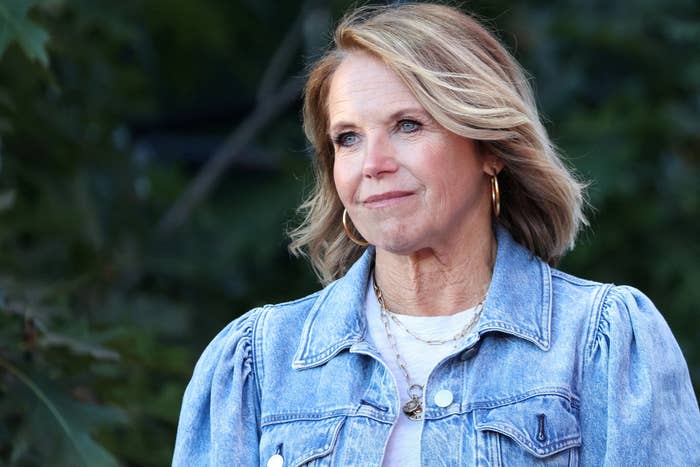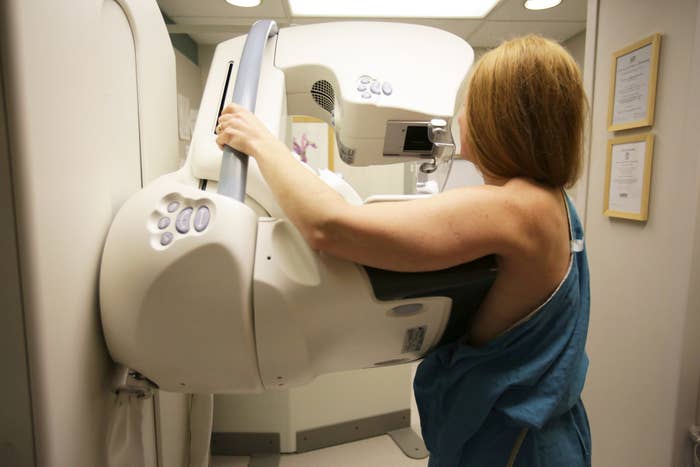
Katie Couric, a longtime proponent of colonoscopies, is now advocating breast cancer screening after a routine mammogram and ultrasound revealed in June that she had a tumor herself.
After a successful lumpectomy and radiation treatment, the 65-year-old journalist is using her experience to stress the importance of breast cancer screening as we head into Breast Cancer Awareness Month this October. Breast cancer, which affects 1 in 8 women, is the most common non-skin cancer in women and the second-deadliest cancer for women, only behind lung cancer.
Couric said she was six months overdue for her mammogram and had intended to film it to raise awareness for the screening procedure, as she had done when the Today show filmed her colonoscopy in 2000. (Her first husband, Jay Monahan, died of colon cancer in 1998.)
“If I had forgotten to schedule a mammogram, this might be a helpful reminder for other people, too,” she wrote in an essay on her website. The reminder is particularly needed now, as rates of mammograms dropped during the pandemic.
Her diagnosis of a stage 1A, olive-sized tumor, though, shined an even greater light on the issue. “Please get your annual mammogram. I was six months late this time. I shudder to think what might have happened if I had put it off longer,” she wrote. “But just as importantly, please find out if you need additional screening.”
Couric also had an ultrasound, which is recommended for people who have dense breasts. Breast density, which is unrelated to the size of your breasts, is an additional risk factor for breast cancer because it can make cancer more difficult to see on a mammogram. Thankfully, her cancer hadn’t spread anywhere else, and she didn’t require chemotherapy.
Bethany Kandel, a New York City–based writer and founder of the breast cancer resources website BreastCancerFreebies.com, had a similar experience.
“Like Katie, I put off my annual mammogram/sonogram — I have dense breasts,” she said. She was only two months overdue, in good health, and had just turned 50. “And when I finally went, there was a small cancerous tumor. I ended up needing surgery — a lumpectomy like Katie — chemo, and radiation.” Kandel wonders, though, if she had gone sooner, whether she would have needed the chemo.
“I beat myself up about it for a while,” she said. “I had scares before that turned out to be nothing, so I wasn’t worried. I should have gone sooner. The outcome may have been the same, but I wouldn’t have felt the guilt I ended up carrying.” Kandel has been cancer-free for 15 years.
There’s no question that mammograms have become a crucial part of healthcare. “Breast cancer screening saves lives,” said Ruth Oratz, MD, a breast cancer oncologist at NYU Langone’s Perlmutter Cancer Center. “Because Katie Couric went for a screening mammogram, her breast cancer was detected when it was small and curable.”
Breast cancer death rates dropped by 40% between 1990 and 2017 as awareness campaigns drew attention to mammograms. “The recent advancement in treatment and improvement in breast cancer survival is due in part to routine screening,” said Nancy Chan, MD, a medical oncologist and director of breast cancer clinical research also at NYU Langone’s Perlmutter Cancer Center.
When should you start getting routine screening mammograms?
When to start getting mammograms, and how often to get them, can vary a bit, depending on which medical organization is making the recommendation.
For example, the US Preventive Services Task Force says the decision to start mammograms under age 50 is an “individual one,” and people over 50 should get them biannually; the American Cancer Society offers a choice under age 45 but then recommends annual mammograms starting at 45; the American College of Physicians says that the potential harms of mammograms outweigh the benefits for most people 40 to 49, and recommends biannual screening for those over 50.
Mammograms do require a small amount of radiation, and because breast cancer risk rises with age, starting regular screenings too early can in some cases lead to unnecessary tests or biopsies — and the psychological stress that can accompany them.
“Different medical organizations have different approaches,” said Jessica Leung, MD, a professor of Breast Imaging at the University of Texas MD Anderson Cancer Center. They may use different data or analytical methods. “But perhaps most significantly, they may have different concepts of benefits versus risks or harms,” she said. “For example, patient anxiety is considered a risk of screening mammography. But how does one quantitate this risk against the benefit of lives saved?”
Many doctors recommend an annual mammogram after the age of 40 for people who have an average risk of breast cancer. Basically, you should talk with your doctor when you turn 40, although you might have that conversation earlier if you have certain risk factors. (For example, if you have a family history of breast cancer, inherited a BRCA1 or BRCA2 gene mutation, or had radiation therapy to the chest between the ages of 10 and 30 you might start sooner.)
“In general we recommend a baseline mammogram at around age 40 and then once a year after that,” Oratz said. Dr. Sheldon M. Feldman, chief of the breast surgery and breast surgical oncology program and director of breast cancer services at Montefiore Einstein Cancer Center, also says to start at age 40 unless there's a history of breast cancer in close family members.
“Mammograms allow early diagnosis and improved survival with less aggressive treatment,” he said, which may mean that if you catch it soon enough, you can avoid chemo or a mastectomy.
Like Dr. Leung, Christine Staeger-Hirsch, an attending physician of breast imaging at Montefiore Health System, follows guidelines from the American College of Radiology.
“There are other guidelines out there, [but] we feel that the best, most inclusive protocol is annual screening mammography beginning at 40 and continuing on beyond 75, as long as you are in otherwise good health,” she said. “It is so important to get your yearly mammogram, so that small subtle changes can be picked up earlier.” Although survival rates are similar at an early or later stage, she said, “the individual treatment for the patient is easier at an earlier stage.”
If you have dense breasts, you may need additional testing

Dense breasts make screening decisions even more complicated — and half of women over 40 have them. “Dense” doesn’t refer to firmness or size, but rather the amount of breast tissue versus fat, Staeger-Hirsch said. Dense breasts come with two concerns, Feldman said: The breast tissue shows up as white on mammograms — as does cancer — making the scan harder to read. Second, for reasons not quite understood, denser breasts have a higher risk of breast cancer.
Thirty-eight states require that people are notified if their mammograms reveal they have dense breasts. “Every mammogram should describe and report the density of breast tissue,” Chan said, but proposed federal regulations have been stalled. What to do about dense breasts isn’t always clear either; it usually leads to a discussion of additional screening with another type of test, such as an ultrasound or MRI. “The upside of supplemental screening is an increase in cancer detection, which is obviously valued,” Leung said. This is how Couric’s cancer was found.
But the downside may be more false positives and the need for further intervention, Leung said. Plus, some insurance companies might not cover additional screening as they do mammograms.
MRIs, for example, are expensive and also require an injection of contrast material; still, Staeger-Hirsch notes that MRIs may be recommended for people with dense breasts and additional risk factors. “Your doctor can help you decide whether additional screening with ultrasound or MRI would be helpful for you,” she said.
An MRI was how Brande Plotnick, a healthcare product marketing manager in Ambler, Pennsylvania, was diagnosed at age 48.
“My doctor did recommend MRI screenings in between my yearly mammograms — but only after I proactively asked about alternative, additional imaging because of my dense breasts and other breast cancer risk factors I knew I had,” she said.
Plotnick had problems getting her MRI covered by insurance. “I was not considered high risk enough for insurance to cover the MRI, so I always paid out of pocket,” she said. An MRI picked up breast cancer, and Plotnick opted for a double mastectomy. She now shows no evidence of cancer.
Additional risk factors may include family history. Couric noted that cancer — but not breast cancer — runs in her family.
Her sister died at age 54 of pancreatic cancer; her mother and father survived non-Hodgkin’s lymphoma and prostate cancer respectively. “Breast cancer and cancer in general may run in families — likely because cancer has a basis in DNA,” Leung said. “But it is important to note that the majority of patients may be diagnosed with breast cancer without any family history of breast cancer.”
What are 3D mammograms?
Yet another option for screening is a 3D mammogram, which Couric said she had.
Called tomosynthesis, this screening method uses X-rays similar to mammography. “Tomosynthesis has been shown to increase cancer detection compared with mammography, but not as much of an increase when compared with ultrasound or MRI,” Leung said.
Feldman recommends 3D mammograms for all patients because they are more accurate with fewer false alarms, and the patient experience is the same as a 2D mammogram. Depending on where you live and your insurance company, you may or may not have coverage for a 3D mammogram.
Complicating breast cancer screening even further are inequities in healthcare, which Couric points out in her essay, writing, “How lucky I was to have access to such incredible care…It made me feel grateful and guilty—and angry that there’s a de facto caste system when it comes to healthcare in America.”
Research has shown Black women are diagnosed with breast cancer at younger ages, have higher rates of aggressive or advanced breast cancer at diagnosis, and are more likely to die from breast cancer than white people.
“Removing access barriers [to healthcare] is vital,” Leung said. “Also key are information and education.” Black people can use the Black Women’s Health Study’s online breast cancer risk calculator as a first step in assessing their individual risk.
If you’ve put off your mammogram during the pandemic, now during Breast Cancer Awareness Month is the perfect time to schedule one, and talk with your doctor about any additional screening you may need.
“We definitely saw an increase in the number of skipped mammograms during 2020 and 2021; unfortunately for some women, this led to delay in diagnosis,” Chan said. “It is understandable that the pandemic has been a challenge and led some to skip their mammogram. I would encourage women who haven’t had their annual mammograms to schedule it and get back on their individual screening schedule.”
